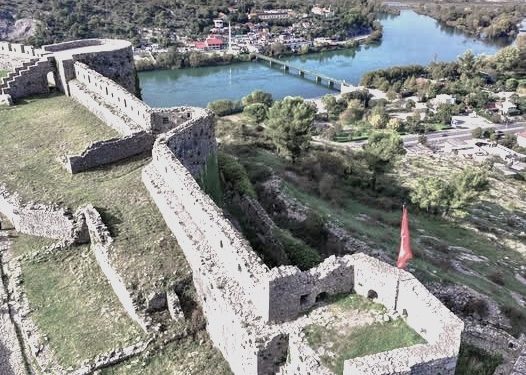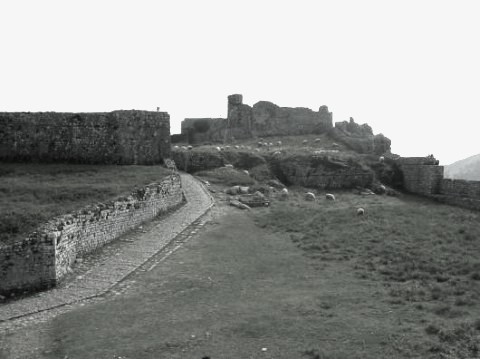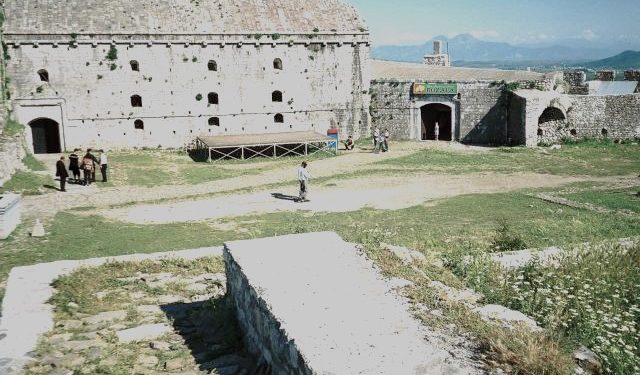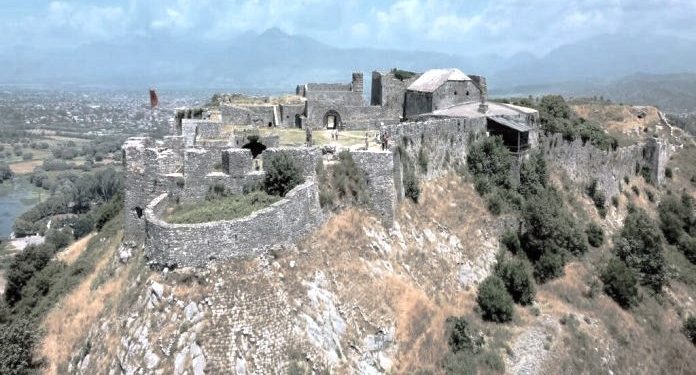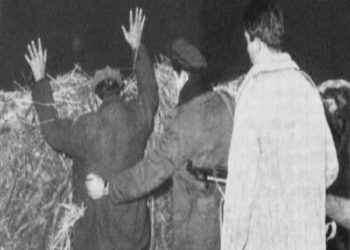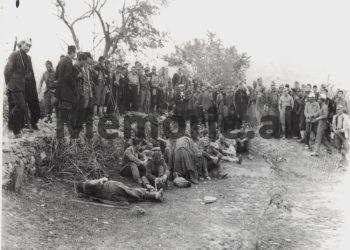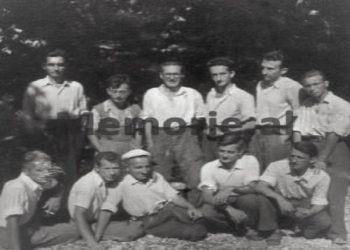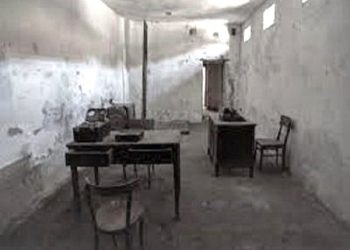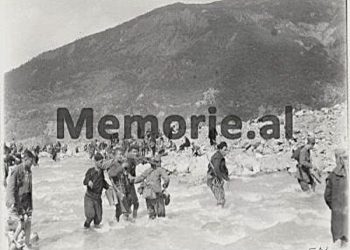The Centuries-Old Pledge of Shkodra: The Unknown History of the Church-Mosque in Rozafa
Memorie.al / Few landmark monuments still remain standing in Northern Albania. One of the most important of these is the ruin of the medieval cathedral church of Shkodra. This place of worship, which at that time was comparable to the magnificent Church of St. Nicholas, also located in the fortress but no longer existing, was one of the city’s most important, because it was dedicated to Saint Stephen (Sanctus Stephanus), the Patron of Shkodra. Being the only church from the middle Ages to have survived in this city, St. Stephen’s deserves the proper care to be saved and brought to light, as a unique medieval document of Shkodra, in its architectural genre.
At a time of great importance for our existence, Shkodra served as the capital of the Ardiaean Kingdom and was immortalized in Greco-Latin chronicles with Gentius’s last, but not well-managed, resistance in the 2nd century BCE. The importance of this center did not fade even under Roman rule, by the end of the 1st century CE, a period when it appeared as a Roman colony called Colonia Claudia Augusta.
The colony was located at the foot of the Illyrian fortress, in the plain by the Buna River (Barbanes), right where the Byzantine fortress would later be built. As was common in European cities with Roman foundations, which inherited their urban structure from former insulae, this colony also served as the nucleus of the post-medieval city. Unfortunately, this part of the city suffered repeated destruction, first from German invasions and then from the Albanian-Serbian dynastic wars, which erased even the last traces under Ottoman rule.
Christianity had taken root on the Adriatic coast as early as the 1st century CE. Holding to what St. Paul wrote – who had preached all the way to Illyricum, i.e., all of our Albania, which was then part of the Roman Province of Macedonia – the influence of this faith penetrated the condition of this city, much earlier than the Illyrian soldiers of Justinian who returned from the Syrian campaign, bringing with them the fervent cult of Sergius and Bachus.
The region of Shkodra and further the areas around the lake or Labeatis Basin, over the centuries, have had their own linguistic idiom, the Labeatic one, with roots in Illyrian but almost Latinized by the Early Middle Ages. They also created an original civilization, always at the edges of empires, which were exchanged and left their visible marks on the territory (Byzantine, Heruli, Carolingian, Bulgarian, Serbian, Arbanon, Venetian, or Ottoman).
As a topic not addressed until today, from the excavations of the last two years, undertaken in the medieval necropolis of Lezha/Elisson by the archaeologist E. Nallbani, traces of rough Carolingian Latinity have been found (at that time, Charlemagne at the head of the Holy Roman Empire managed to retake Dalmatia from the Byzantines). Perhaps it is precisely in this cultural substratum that one should seek the invitation that this coveted city naturally makes, not only to visitors but to all the inhabitants of other Albanian regions.
Despite the debate on how far St. Paul preached (by symbolic coincidence, he was also one of St. Stephen’s executioners) – a debate in which the fact that Illyricum started exactly in the region of Labeatia should not be left in the dark, because the rest of today’s Albania at that time was called Macedonia – the veneration for the first saint of Christianity here was primary, even compared to the cult for saints Sergius and Bachus.
The veneration for him was so great that this saint was chosen as the Patron of Shkodra. The city’s community, centuries later, sanctioned this superiority in the final provisions of the Medieval Statute of Shkodra, which states that if someone: “acts contrary to them (the provisions of the Statute), may the curse of God, of the Virgin Mary, of the 12 Apostles and of our patron Saint Stephen, as well as of the martyrs Saint Sergius and Saint Bachus, fall upon him and his heirs.” As if that were not enough, the community sanctioned its choice also at the time of the cathedral’s construction, by minting silver coins in Shkodra in the years 1321-1322, on the reverse of which was written “S. Stefanus di Scutari”.
Who was Saint Stephen?
According to official hagiography, he is considered the first martyr of Christianity – the protomartyr. Of course, what has reached our days from his life is mixed with a lot of legend and little truth, but it remains an interesting story nonetheless.
It is moving what is narrated about the appearance of Stephen (Stephanus-Stefan). Among the shepherds who rushed to adore the birth of Christ, there were also women, each of whom took a newborn lamb with her, to place it next to this divine creature. Tekla, a young childless wife, so as not to be singled out from the other women, took a large stone, wrapped it in a shawl, and held it in her arms like a newborn baby. When she saw Jesus, the small, luminous lamb, she fell to her knees and began to sob.
After she collected herself and stood up again, Mary, who had understood her great longing, asked her what she was holding in her arms. Faintly, the woman replied that she was suckling a son, and then the Mother of Christ said to her: “Give your son to your breast now, for your wish has been fulfilled!” The woman unwrapped the shawl that covered the stone and was stunned. A miracle had indeed given her a son. “But listen,” Mary said to her, “he was born from the stone and he will end by the stone.”
He was named Stephen and was the first to give his life for the spread of the Gospel. For this reason, Christianity knows him as the protomartyr, celebrating his liturgical feast of saints on December 26, and right after Christmas. His devotion and subsequent martyrdom are witnessed in the Acts of the Apostles. St. Stephen was accused around the year 33 CE, before the Sanhedrin (the High Court of Israel) for insulting the sacred law and was sentenced to be stoned to death. Among the crowd that was dragging him to kill he was Saul – the future St. Paul.
It is also witnessed that in 415 CE, a priest named Lucian revealed that he had found Stephen’s body near Jerusalem. The impetus to find his burial place had been a dream he had seen. The relics were taken to Constantinople, and their legend spread rapidly in the Greco-Latin world, also due to the fact that a number of relics were often speculated upon, which were unlikely to all be original. But if nothing else, this also contributed to the unparalleled spread of his cult from a geographical point of view.
The Historical-Religious Context
The importance of saving this ruin remains primordial for the history of Shkodra and Albania. This church, once a basilica, was the nucleus around which the medieval center within the castle developed, i.e., the compositional nucleus of the city, along the main road that crossed the castle-city and connected the Entrance Gate with the fortified residence of the Count-Captain (capitaneria).
Like many other churches that were dedicated to St. Stephen in Europe and were built on the ruins of earlier churches, this one, it is likely, was also built on even older foundations. This is what happened with the Church of Shirq (see Isambert), but also with that of Our Lady of Good Counsel, in whose foundations in 1921, parts of a mosaic of the former basilica were found.
In 1248, to stop the Orthodoxization of the Balkans, Pope Innocent IV had sent his friend, the Franciscan Carpini (Ioannes de Plano Carpini), as archbishop to Tivar. He had been his trusted ambassador and was completely successful in the life-threatening mission to the Mongol emperor Güyük. After this appointment, Albania/Rabana became the center of the anti-Orthodoxization operation in the Balkans. Carpini, with his policy, brought Franciscan and Dominican missionaries to these regions for the first time, who replaced the Benedictines.
Seeing the great density of the city within the walls and perhaps the non-fulfillment of functions by the existing churches there, Helena of Raška in the year 1288, opened the way for the construction of the Church of St. Nicholas. The novelty brought by this construction was not only the innovative style of construction but also the fact that it belonged to the Franciscan Order, which must have been a request of the Latins and Albanians of the city, who, according to historical data, were under strong pressure from the Serbian monarchical orthodoxy. As is often cited, Lenë Anjou, with her devotion and origin, was a strong guarantee for the anti-Orthodox resistance of the Albanians in the region.
The care of the Frenchwoman Helena for the mendicant orders of the Franciscans and Dominicans had its roots in the fanatical French Catholicism. This fact is very important, because according to scholars, even in the year 1300, the population in Albania belonged to two faiths: Orthodox and Catholic. Of the Orthodox faith in Durrës, the Greek rite predominated; while in the provinces of Shkodra, Ulcinj, Tivar, the Catholic religion of the Slavic rite was practiced.
This complexity stemmed from the difficult Albanian-Slavic coexistence, the wavering of the Serbian kings between Catholicism and Orthodoxy, but also from historical-geographical motives that had always connected the Adriatic coast with the West. As a reminder, in 1274, at the Council of Lyon, the union of the two churches was announced, on the basis of which Byzantium promised obedience to the Holy Roman See.
In 1290, Helena rebuilt the Church of Shirq from its foundations, bringing the Dominicans there and thus making this monastery transform into the most important center of Dominican abbeys in Albania (Šufflay). A year later, Pope Nicholas IV praised the Catholic Helena, who informed him that she would take care to convert to Catholicism, not only the Serbian king but also the Bulgarian Tsar himself.
The Cathedral Church, the Mosque, the Gunpowder Depot
Religious devotion for St. Stephen had gained powerful momentum in the 12th century (to be precise in the year 1110), after the looting of his reliquary in Constantinople by the Venetian prior Pietro. The reliquary was taken to Venice and placed in the church of San Giorgio Maggiore, where it immediately became a pilgrimage motive for believers from all over Europe. And not only Venice, but all the churches dedicated to the saint became centers of a continued pilgrimage.
Helena of Raška died and was buried in the church of St. Nicholas in Shkodra. Five years later, around the year 1319, it seems that the Cathedral Church of St. Stephen was also completed, taking on the appearance of the construction that is still seen today. A document from that year serves as data to date the completion of the works, in which it is announced that the Shkodran cleric Andra sent three carpenters from Ragusa to complete the roof of the choirs. This church, like that of St. Nicholas, is presented in a Romanesque-Gothic style, already widespread in the territory of Dalmatia and Northern Albania.
Smaller in scale, due to the narrowness of the ground in the overpopulated fortress, the church contained all the architectural canons of the Dalmatian Romanesque-Gothic style, which had long been influenced by Italian architecture. Just as the Church of Shirq was designed by Pjetër Dokne Scutarensis, or some years later the famous Monastery of Dečani was designed by a master who “fu un albanese, certo Mikele di Antivari,” the church of St. Stephen must also have been an intermediate style of these two exemplary churches. As for the planimetric typology, typical of the Western Mendicant Orders, it resembles more the Church of Çetë near Kavaja.
Covered with a crossed vault, pointed arches (ogival) of the Gothic type and ribs modeled according to the late Romanesque, this church, from what information it conveys, seems to have resembled the Venetian Gothic, which was spreading on the eastern coast of the Adriatic. Like many churches and chapels scattered throughout Dalmatian Albania, St. Stephen’s retained its apse directed towards the East, respecting the tradition that originated from early Christianity and which, referring to St. Athanasius of the 4th century, “apostolos jussisse ut ecclesiae christianorum orientem spectarent.”
As for the decorative aspect, at the beginning of the 9th century in Southern Dalmatia, a Benedictine sculpture school was formed that operated in Ragusa, Kotorr, and Ulcinj, while as for the decoration of the interiors, the churches were decorated with frescoes, often of the oriental style, probably by Byzantine painters settled in Venice, who passed through Arbani.
It should be emphasized that in this period, Western painting did not yet have primacy over Eastern painting, and a lively flux of artists was involved in the local schools of Constantinople, Morava, or Raška and worked on commission for the local aristocracy. Thus, for example, in 1295, the best painters of the Balkans together set up a studio and worked in Ohrid on commission for the Albanian nobleman, Progor Skura.
A Renaissance-era Fresco on the Martyrdom of Stephen
St. Stephen’s endured well the turmoil of the civil war of 1331, when the court of the Serbian kings with very beautiful palaces (Šufflay) was ruined in the war for the throne, but also the anti-Serbian revolt of 1332, when the Albanian aristocrat Dhimitër Suma, according to the Archbishop of Tivar, led “the Albanians badly oppressed by the unbearable and very heavy yoke of the hated and difficult Slavic rulers.” After a long time, in 1403, the cathedral church underwent a major reconstruction with the raising of the damaged roof and the addition of the southern portico.
The Cathedral of St. Stephen, with its position, is the only remaining Shkodran building that felt the shots of the continental cannons of Mehmed the Conqueror, which saw the glory of 1474, immortalized in Paolo Veronese’s lively fresco in the Venetian Palace of the Doges, but also the fatal heroism of 1479. It was there, transformed into a mosque, a witness to the Autonomous Principality of the Bushatlliu in the eighteenth century, but also there in 1913, turned into a gunpowder depot, perhaps so as not to see the Albanian who handed over Rozafa to the Montenegrins.
In fact, the church was converted into a garrison mosque immediately after the fortress was handed over to Ahmed Evrenoz. An elegant brick minaret was added to the new mosque, which, according to someone, would bear the name of Mehmed II – the Conqueror (Fatih), attaching it to the apse. In fact, this conversion truly saved this monument that would have otherwise found the fate of the eight other known churches in the Fortress of Rozafa. The building maintained this new function until the 1830s and no longer functioned as a place of worship after 1863, when the administrative center of Shkodra descended from the Castle and was relocated to the territory occupied by the present-day city.
After this year, it was transformed into a gunpowder depot, a function it had until that fatal day when it exploded due to the carelessness of the castle’s dizdar. Thus it remained a ruin and no one cared for it anymore. The existence of altar fragments inside the former church is an element that has intrigued many scholars and naturally leads to the formulation of the hypothesis that the interior may have never been used as a mosque, since in none of the Christian places of worship that were functionally converted into Muslim places of worship is the presence of an altar found inside them. Consequently, the prayers must have been offered in the field in front of the building, while the magnificent minaret played its communicative role very well.
The acts of the surrender of the fortress to the Ottomans and the corresponding conditions have never been found, and no one today can say for sure whether the Venetians had set any condition that guaranteed the non-demolition of that building dedicated to the Patron of the city. It should not be forgotten that the Christians were free to remain in the city even after its surrender, and many historians have always doubted the complete emptying of the fortress of all Christians, an obligation which naturally also includes the preservation of at least one of their own liturgical environments.
The last damages were caused by the earthquake of 1905, which, among other things, knocked down a part of the minaret, but also by that of 1979, which mainly damaged the eastern wall of the nave. The partial but necessary repairs that the Institute of Monuments immediately undertook in 1980, with the aim of consolidating this unique ruin for pre-Ottoman Shkodra, remained unfinished.
The effort to finally restore the ruins of this relic that has no equal in Northern Albania, a restoration that would highlight the values of Romanesque-Gothic and Ottoman art for us, is being hindered by the Muftiate of the city of Shkodra and by the blindness of the Albanian institutions responsible for national monuments. / Memorie.al




